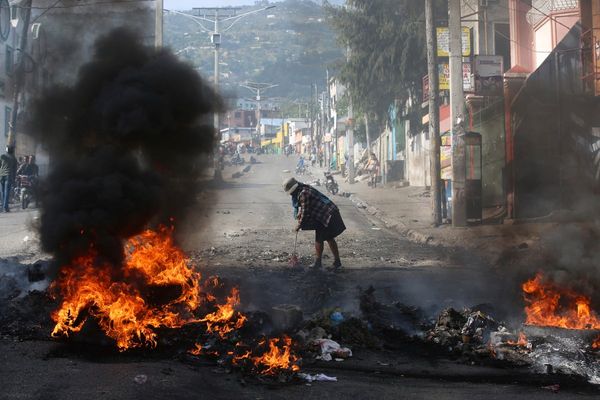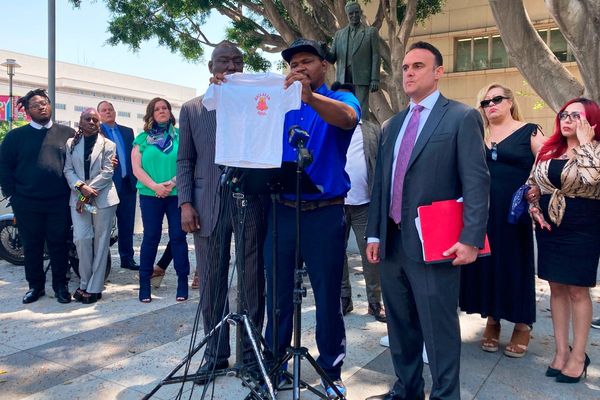
Closing summary...
The time is about 21:22 in Mandalay, Myanmar, and 21:53 in Bangkok, Thailand. Here is a round up of what has happened today:
About 1,700 people have died as a result of the Myanmar earthquake with at least 300 people having been reported missing, according to the country’s ruling junta (the military government).
About 3,400 are injured, according to officials, with the death toll expected to rise significantly.
The Red Cross said the devastation is the worst seen in Asia in more than 100 years.
The United States Geological Survey (USGS) reported that a 5.1 magnitude aftershock hit 28km (17.4 miles) northwest of the central Myanmar city of Mandalay earlier today, the latest in a string of aftershocks.
The initial 7.7 magnitude quake struck near Mandalay early on Friday afternoon, followed minutes later by a 6.7-magnitude aftershock.
The earthquake affected parts of neighbouring Thailand, bringing down an under-construction skyscraper and killing at least 18 people across the capital, according to Thai authorities.
At least 76 people remained trapped under the debris of the collapsed Bangkok building, where rescue operations continued for a third day. At least 11 people were killed as a result of the collapsed skyscraper.
Critical infrastructure - including bridges, highways, airports and railways - across Myanmar has been damaged, slowing humanitarian efforts.
India, China and Thailand are among Myanmar’s neighbours that have sent relief materials and teams, along with aid and personnel from Malaysia, Singapore and Russia, among others.
Anti-junta fighters in Myanmar have declared a two-week partial ceasefire in earthquake-affected regions starting on Sunday. The military, however, reportedly continued airstrikes after the earthquake, including just hours after it first hit.
Thanks for following along today. We are now closing this blog.
A pregnant woman pulled from a collapsed apartment block in Mandalay, Myanmar’s second-largest city, on Sunday after more than 55 hours under the rubble was pronounced dead shortly after she was freed, according to journalists from the Agence France-Presse (AFP) news agency at the scene.
Rescuers thought they had saved the life of Mathu Thu Lwin, 35, but they were unable to resuscitate her after extracting her from the wreckage of the Sky Villa apartment complex, demolished by the powerful quake that hit Myanmar on Friday.
The Bangkok Metropolitan Administration has issued a press release with updates about the earthquake. Here is a summary of what was said:
18 people in Thailand have been killed by the earthquake (11 were killed as a result of the collapsed skyscraper in Bangkok, the area in Thailand worst affected by the quake)
Rescuers have detected signs of life under the rubble at the collapsed building site in the Thai capital
Officials are conducting building inspections across the Bangkok metropolitan area
Traffic conditions in Bangkok are gradually improving. Din Daeng Expressway is expected to reopen early tomorrow morning
People injured by the earthquake or those whose properties have been damaged by it will be entitled to compensation
Essential services such as hospitals are back operating at full capacity in Thailand
Parents are advised to check with schools to see if they remain closed
Updated
We have some before and after satellite images showing the extent of the damage caused by the deadly 7.7 magnitude earthquake that hit Myanmar on Friday (it struck nearby the country’s second largest city, Mandalay, at about 06:20 GMT):
Updated
Which countries have sent aid or rescue teams to Myanmar?
Thailand: Rescue teams and aid have been arriving from donor countries around the world, with Thailand dispatching 55 military personnel and six rescue dogs, along with equipment including cranes and diggers, earlier today.
China: Beijing has sent an 82-person team of rescuers to Myanmar on Saturday, Beijing’s emergency management ministry said. The Chinese government will also provide Myanmar with 100 million yuan ($13.8m) in emergency humanitarian assistance, with shipments to begin Monday, its international aid agency has said.
Hong Kong: A 51-person team from Hong Kong has arrived in Myanmar. The city also sent two search and rescue dogs and nine tonnes of equipment, including life detectors. The city has earmarked HK$30m ($3.8m) for emergency relief support to Myanmar, it said in a statement.
India: An Indian aid flight landed in Myanmar on Saturday, with more on the way. India’s foreign ministry said a military transport plan, accompanied by a search and rescue team, had been dispatched carrying hygiene kits, blankets, food parcels and other essentials. Four more aircraft were being sent with personnel and equipment, including a field hospital, as well as two navy ships, officials said.
Malaysia: Malaysia’s prime minister, Anwar Ibrahim, said his government has decided to “channel humanitarian assistance totaling RM10 million ($2.2m) to the people of Myanmar” affected by the tragedy. The country’s foreign ministry said it would send a 50-person team to Myanmar “to support ongoing humanitarian and disaster relief operations”.
Other countries that have sent rescue teams and/or said they would be sending aid include Vietnam, Russia, the US, Indonesia, Ireland, Britain, South Korea, New Zealand and the Philippines.
Updated
Michael Dunford, the UN world food programme’s country director in Myanmar, has spoken to Al Jazeera about the humanitarian crisis following the deadly earthquake.
He said:
The needs in the country are enormous. This was already a humanitarian crisis before the earthquake and this event has just exacerbated what already was a very difficult situation for the population.
This is a country that already had over 19 million people requiring humanitarian support because of the ongoing conflict which has been raging for the last four years.
We are hopeful that with international support we can respond and that we will be given the facilitation required from the authorities to reach the population.
Sadly, Myanmar has been on a gradual decline over the course of the civil war. This is just going to make the situation even more difficult. We need to be able to reach the population, we need to be able to move into areas that we previously haven’t had the access required.
Only with this ability we will be able to provide the type of humanitarian support the population of Myanmar desperately requires at this point.
At least 18 people in Bangkok killed by earthquake, Thai officials say
Thai authorities have increased the death toll of the number of people killed by the earthquake in Bangkok. It now stands at 18, up from 17 previously.
Officials say at least 11 people were killed as a result of the 30-storey Bangkok skyscraper collapsing just across from the tourist landmark Chatuchak market.
At least 76 people remained trapped under the debris of the collapsed building, where rescue operations continued for a third day, using drones and sniffer dogs to hunt for survivors. Dozens of other people have been reported injured.
As we touched on in our post at 9.15am BST, efforts to locate survivors have been hampered by aftershocks – and an apparent lack of robust rescue equipment.
One rescue worker said most operations in the city were being conducted by small, self-organised resident groups that lack the necessary tools.
Rescue personnel at the site of a building that collapsed in Mandalay. Scores of people are feared to be trapped across the city.
“We have been approaching collapsed buildings, but some structures remain unstable while we work,” he said, asking not to be named because of security concerns.

Scores of people were feared trapped under collapsed buildings across Mandalay but most could not be reached or pulled out without heavy machinery, another humanitarian worker and two residents said.
“People are still stuck in the buildings, they can’t take people out,” said a resident who also asked not to be named.
Which areas in Myanmar have been devastated by the earthquake?
Friday’s earthquake struck Mandalay, which is Myanmar’s second largest city.
As we’ve been reporting, the tremors collapsed buildings, downed bridges and buckled roads, with mass destruction seen in the city of more than 1.7 million people.
As officials and rescuers grapple with the devastation caused by the quake, the extent of the damage caused is only now becoming clear.
The International Federation of Red Cross and Red Crescent Societies says critical infrastructure has been destroyed - including the historic Ava Bridge connecting Sagaing and Mandalay, Mandalay University and various heritage sites, the Associated Press is reporting today.
Myanmar sits on the major north-south Sagaing Fault, which separates the India and Sunda plates, and the widespread damage runs down a wide swath of the middle of the country.
Significant damage also has been reported in the Sagaing, Naypyidaw, Magway, Bago and Shan State regions, while telecommunications outages continued to hamper emergency coordination in several regions, the Red Cross said.
Updated
Aftershocks frighten Myanmar survivors while death toll from Bangkok high-rise collapse rises
The children at Bright Kids nursery in Kyaukse, a town south of Mandalay, were taking a nap when the earthquake struck on Friday afternoon. The two-storey building collapsed with dozens of children aged between two and four trapped inside. For hours, rescuers sifted through the rubble, searching desperately for survivors.
“We were clearing the building using diggers and rescuing people with manual tools,” said Thar Nge, a volunteer. They needed better equipment – metal cutters and generators – but made use of what they had. Thar Nge helped carry a four-year-old girl to safety. She pleaded, over and over, for him to save her, he said. He held a bottle of water to her mouth before her dusty body was freed.

The girl was among 12 children saved, along with four teachers. A further 16 children and a teacher were found dead. Thar Nge barely had time to feel any emotion.
Afterwards, his team of 11 volunteers moved onwards across Kyaukse, one of many areas devastated by Friday’s earthquake.
Similar scenes have played out across central Myanmar, with teams of volunteers using anything at their disposal to free survivors, digging with their bare hands and crawling through collapsed structures, often with no safety equipment.
Myanmar earthquake: what we know so far
If you’re just joining us, here are the latest developments as the search for survivors continues in the wake of Friday’s disaster in Myanmar:
At least 1,700 people have died in the 7.7 magnitude quake with at least 300 people having been reported missing, according to Myanmar’s ruling junta. About 3,400 are injured with the death toll expected to rise significantly.
The Red Cross says the devastation is the worst seen in Asia in more than 100 years.
The United States Geological Survey (USGS) reported that a 5.1 magnitude aftershock hit 28km (17.4 miles) northwest of Mandalay, the latest in a string of aftershocks following Friday’s devastating earthquake.
The UN has warned rescue operations have been severely hampered by the blocked roads and collapsed buildings, adding that a lack of medical supplies is making the response to the earthquake much more difficult than it would be otherwise.
Updated
Devastation from Myanmar earthquake 'hasn't been seen in over a century in Asia' - Red Cross
Red Cross officials have warned that Myanmar faces a humanitarian crisis after the deadly 7.7-magnitude earthquake.
“What we’re seeing here in Myanmar is a level of devastation that hasn’t been seen over a century in Asia,” the International Federation of Red Cross and Red Crescent Societies (IFRC) wrote in a post on X.
“This is not just a disaster; it is a complex humanitarian crisis layered over existing vulnerabilities,” Alexander Matheou, regional director for Asia Pacific at the IFRC, said in a separate statement.
“The magnitude of this disaster is substantial, and the need for support is urgent,” he added. The IFRC has launched an emergency appeal for 100 million CHF ($113.6m; £87.3m) to assist 100,000 people with life-saving relief and early recovery support.
The Myanmar Red Cross Society (MRCS) has mobilised hundreds of trained volunteers to provide relief in the form of first aid, health care and the distribution of items such as blankets and hygiene kits.
But the UN says aid operations are being hindered by damaged roads and that hospitals in central and northwestern Myanmar in particular are struggling to cope with the influx of people injured in the earthquake.
In some of the country’s hardest hit areas, residents have said that government assistance was scarce so far, leaving people to fend for themselves.
Myanmar’s military junta has put out a rare call for international aid. India, China and Thailand are among Myanmar’s neighbours that have sent relief materials and teams, along with aid and personnel from Malaysia, Singapore and Russia.
Updated
Earlier in the blog we reported that 12 people had died at the scene of the collapsed building site in Bangkok (see post at 09.15). Now Thai authorities have revised this figure down to 11.
Families 'forced to cremate loved ones in the street' after Mandalay crematoriums overwhelmed- report
Myanmar Now, a news agency based in Myanmar, is reporting that crematoriums in Mandalay are struggling to cope with the surge in dead bodies being brought to it after Friday’s devastating earthquake which officials say has killed at least 1,700 people.
It reports that major cemeteries, including Kyanikan, Taung-Inn, and Myauk-Inn, are overwhelmed in Myanmar’s second-largest city, which has a population of about 1.5 million people.
The outlet has been told that some grieving families are being forced to cremate relatives outside designated burial grounds. Some are reportedly cremating loved ones in the street.
“Yesterday, we cremated over 300 bodies. This morning, more than 200 have already been processed,” a resident at a cremation site told Myanmar Now.
Mandalay's crematoriums reach breaking point as earthquake death toll soars. Bodies pile up, forcing families to cremate loved ones in the streets.https://t.co/MFBNDNqMMD pic.twitter.com/nfz5eL4sm0
— Myanmar Now (@Myanmar_Now_Eng) March 30, 2025
Updated
Here are some of the latest images being sent to us over the newswires from Thailand and Myanmar:
What is the political situation like in Myanmar?
Myanmar has been in crisis since the military overthrew the elected government of Aung San Suu Kyi in 2021, sparking mass protests that escalated into an armed rebellion against the junta (Myanmar’s military government).
Government forces have lost control of much of Myanmar after a four-year civil war against rebel groups, and many places are now too dangerous for aid groups to reach.
More than 3 million people have been displaced by the fighting and nearly 20 million are in need, according to the UN.
Anti-junta fighters in the country have declared a two-week partial ceasefire in earthquake-affected regions starting on Sunday, the shadow national unity government has said.
The military, however, reportedly continued airstrikes after the earthquake, including just hours after it first hit.
“Reports that Myanmar’s military has continued with airstrikes after the earthquake tells you everything you need to know about the junta - obsessed with its brutal repression of civilians and desperately trying to win the war whatever the human cost,” Elaine Pearson, Asia director at Human Rights Watch, wrote on X.
Updated
Myanmar earthquake death toll increased to an estimated 1,700 people
Providing an updated death toll, Myanmar’s ruling junta has said in a statement issued today that about 1,700 people have been killed by the earthquake, about 3,400 injured and around 300 more remain missing.
The death toll is expected to rise significantly.
Myanmar’s military leadership previously said that at least 1,600 people were killed and more than 3,400 injured as as result of Friday’s earthquake.
Updated
What caused Myanmar and Thailand earthquake and how big was it?
Nicola Davis is the Guardian’s science correspondent
Earthquakes arise when huge slabs of rock that make up the Earth’s crust, known as tectonic plates, move against each other. According to the United States Geological Survey (USGS), the Myanmar quake occurred as the result of “strike slip faulting” between the India and Eurasia plates – meaning that these two tectonic plates rubbed sideways against each other.
“The quake happened on the Sagaing fault, which marks the tectonic plate boundary between the Indian plate to the west and the Eurasian plate to the east. The Indian plate is moving north along the fault compared to the Eurasian plate,” said Bill McGuire, emeritus professor of geophysical and climate hazards at University College London.
The USGS says the region has experience several similar large strike slip earthquakes in the past, with six occurring within about 250km of the current earthquake since 1900 that were magnitude 7 or greater.
“This is a major quake by any standard, and its impact is made far worse by the fact that it was very shallow – only about 10km down. If it had been 100km deep, the impact would have been much smaller, so depth as well as size is critical,” said McGuire.
5.1 magnitude earthquake hits near Mandalay in Myanmar, US Geological Survey says
The United States Geological Survey (USGS) is reporting that a 5.1 magnitude aftershock has hit 28km (17.4 miles) northwest of Mandalay, in the Mattara township, the latest in a string of aftershocks following Friday’s devastating earthquake.
The 7.7 magnitude earthquake hit around Friday afternoon with an epicentre near Mandalay, Myanmar’s second-largest city, destroying many buildings and damaging other infrastructure like the city’s airport.
Many of Mandalay’s 1.5 million people have spent the last two nights sleeping on the streets, either left homeless by the earthquake or worried that the continuing aftershocks might cause structures left unstable to collapse.
People screamed in the streets on Sunday when a 5.1 magnitude aftershock hit at 15:38 local time (09:08 GMT), but there were no immediate reports of further damage, according to the Associated Press.
Updated
Emergency workers search for people trapped under site of collapsed Bangkok building
The 7.7-magnitude earthquake hit central Myanmar, with tremors felt in Thailand, China and India.
In neighbouring Thailand, the earthquake affected the greater Bangkok area, home to around 17 million people, and other parts of the country.
Many places in the north reported damage, but the only casualties were reported in Bangkok, which is located over 1,000km (621 miles) from the epicentre of Friday’s earthquake.
Rescuers in the Thai capital are continuing to work to rescue survivors trapped when a 30-storey skyscraper under construction near the famous Chatuchak market collapsed after Friday’s earthquake. At least 12 people have been confirmed dead at the site of the collapsed high-rise building and dozens of others reported injured.
Workers at the site of the under-construction state audit office’s building are using large mechanical diggers in an attempt to find victims still trapped under the debris.
“We are still trying to get under the rubble because the 30 floors of the building piling up is really difficult to get through,” Thawida Kamolvej, Bangkok’s deputy governor, told BBC News .
“We still have 79 missing. I am still confident in my team. We are going to continue working around the clock, we have more people coming in. I have to find them,” she added.
Updated
Race to search for survivors continues as UN warns medical supply shortage is hampering rescue efforts
Welcome back to our live coverage of the aftermath of the deadly Myanmar earthquake which has killed at least 1,600 people and injured over 3,400 others, with at least 139 more missing.
Rescue efforts are entering their third day and attempts to find survivors are intensifying after the devastating 7.7 magnitude earthquake struck the country and neighbouring Thailand, where at least 17 people in Bangkok have died.
The initial quake struck near the central Myanmar city of Mandalay early on Friday afternoon, followed minutes later by a 6.7-magnitude aftershock.
The tremors collapsed buildings, downed bridges and buckled roads, with mass destruction seen in the city of more than 1.7 million people, the country’s second largest.
The UN has warned that rescue operations are severely hindered by the blocked roads and collapsed buildings, adding that a lack of medical supplies is making the response to the earthquake much more difficult than it would be otherwise.
Hospitals in parts of central and northwestern Myanmar, including Mandalay and Sagaing, were struggling to cope with the influx of injured people, according to the UN office for the coordination of humanitarian affairs (OCHA).
“A severe shortage of medical supplies is hampering response efforts, including trauma kits, blood bags, anaesthetics, assistive devices, essential medicines, and tents for health workers,” OCHA said in a statement on Saturday.
Marcoluigi Corsi, UN resident and humanitarian coordinator for war-torn Myanmar, said Myanmar had already been “reeling from an alarming humanitarian crisis, largely driven by persistent conflict and recurrent disasters”.
“At this critical time, the people of Myanmar urgently need the steadfast support of the international community,” he added.
Updated







